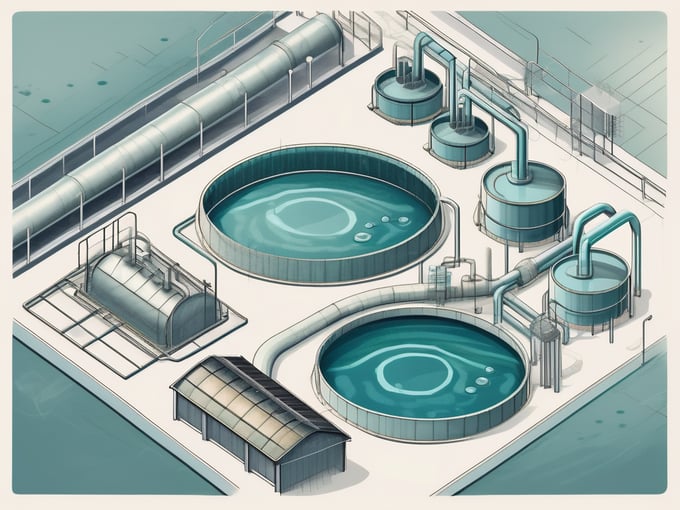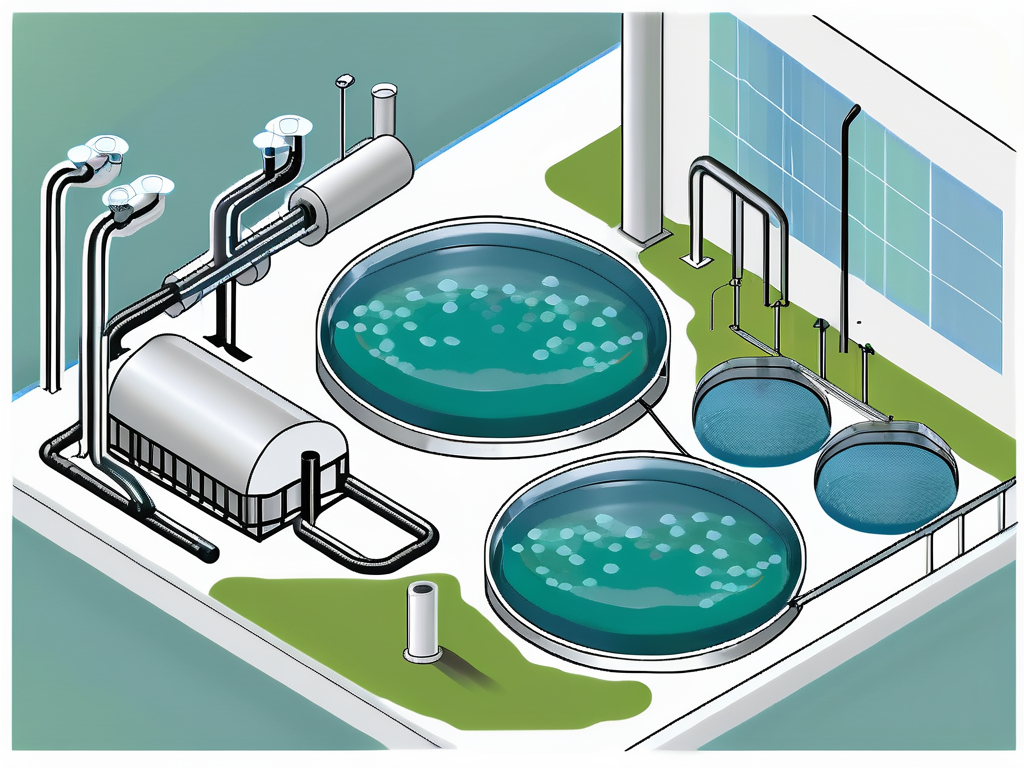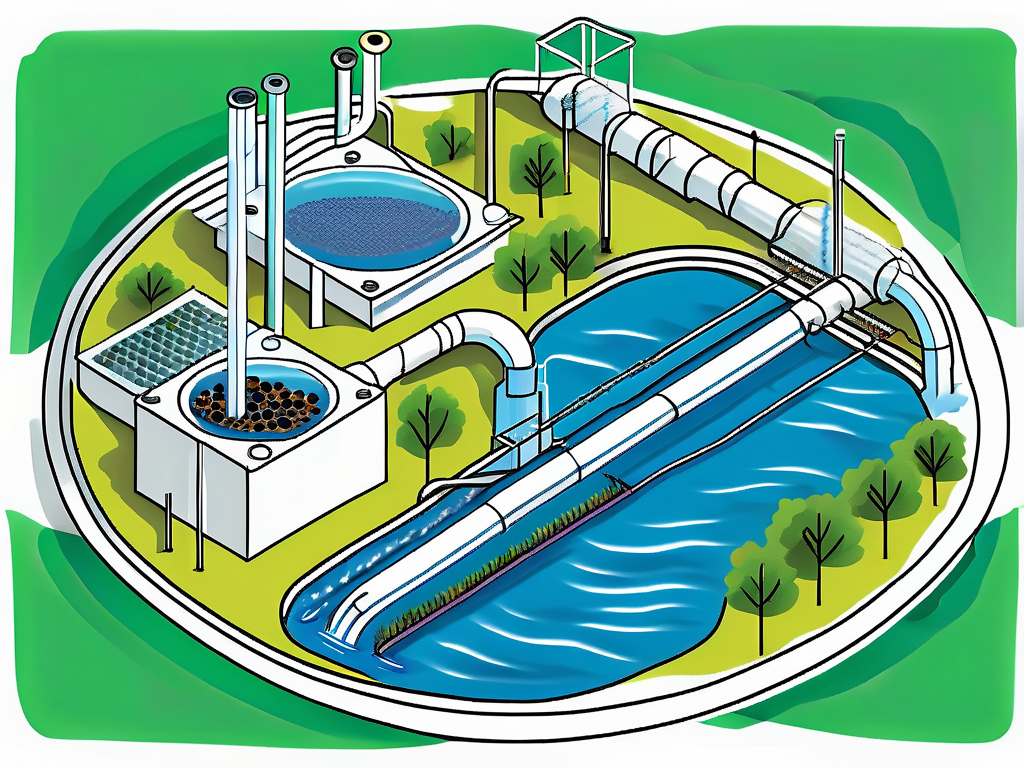
Secondary Treatment: Wastewater Treatment Explained
The secondary treatment of wastewater is an essential step in the process of making water safe for discharge back into the environment. This process involves the removal of organic matter and suspended solids that have not been removed during the primary treatment stage. The secondary treatment is a biological process that uses microorganisms to break down organic matter in the wastewater.
Secondary wastewater treatment is a complex process that requires a deep understanding of the principles of microbiology, chemistry, and engineering. This glossary article aims to provide a comprehensive explanation of the secondary treatment process, its components, and its importance in the overall wastewater treatment process.
Understanding the Wastewater Treatment Process
The wastewater treatment process is a series of steps designed to remove pollutants and contaminants from wastewater before it is discharged back into the environment. This process is crucial for maintaining the health of our water bodies and the organisms that live in them.
The treatment process is typically divided into three stages: primary, secondary, and tertiary. The primary treatment involves the physical removal of large solids and particles from the wastewater. The secondary treatment, which is the focus of this glossary entry, involves the biological breakdown of organic matter. The tertiary treatment involves the removal of any remaining contaminants and the disinfection of the water before it is released back into the environment.
Importance of Secondary Treatment
The secondary treatment stage is crucial because it removes the bulk of the organic matter from the wastewater. This organic matter, if not removed, can deplete the oxygen levels in the water bodies where the wastewater is discharged, leading to the death of aquatic life.
Moreover, the microorganisms used in the secondary treatment process can also break down many harmful substances that can be present in the wastewater, such as certain types of bacteria and viruses. This makes the secondary treatment an essential step in ensuring the safety of the treated water.
Components of Secondary Treatment
The secondary treatment process involves several components, each designed to facilitate the biological breakdown of organic matter. These components include aeration tanks, secondary clarifiers, and sludge digesters.

Each of these components plays a crucial role in the secondary treatment process, and their proper functioning is essential for the effective treatment of wastewater.
Aeration Tanks
Aeration tanks are where the actual biological breakdown of organic matter takes place. In these tanks, wastewater is mixed with a concentrated solution of microorganisms, known as activated sludge. The mixture is then aerated to provide the oxygen necessary for the microorganisms to break down the organic matter.
The aeration process also helps to mix the activated sludge with the wastewater, ensuring that the microorganisms come into contact with the organic matter. This is crucial for the efficient breakdown of the organic matter.
Secondary Clarifiers
After the aeration tanks, the wastewater is sent to the secondary clarifiers. These are large tanks where the activated sludge is allowed to settle to the bottom. The clarified water, which is now largely free of organic matter, is then removed from the top of the tank.
The settled sludge, which contains the microorganisms, is then returned to the aeration tanks to be used again. This process of returning the sludge to the aeration tanks is known as the return activated sludge (RAS) process.
Sludge Digesters
The excess sludge that is not returned to the aeration tanks is sent to the sludge digesters. In these tanks, the sludge is further broken down by anaerobic bacteria, which do not require oxygen to function. This process reduces the volume of the sludge and makes it safer for disposal.
The digestion process also produces biogas, which can be captured and used as a source of renewable energy. This makes the digestion process not only an important part of the wastewater treatment process, but also a potential source of sustainable energy.
Microorganisms in Secondary Treatment
The microorganisms used in the secondary treatment process are a diverse group of bacteria, protozoa, and fungi. These microorganisms are naturally present in wastewater and are cultivated in the aeration tanks to form the activated sludge.
The specific types of microorganisms present in the activated sludge can vary depending on the characteristics of the wastewater and the specific conditions in the aeration tanks. However, all these microorganisms share the ability to break down organic matter in the presence of oxygen.
Role of Microorganisms
The microorganisms in the activated sludge play a crucial role in the secondary treatment process. They break down the organic matter in the wastewater, converting it into carbon dioxide, water, and new microbial cells. This process is known as aerobic respiration.
Some microorganisms can also break down other harmful substances in the wastewater, such as certain types of bacteria and viruses. This makes the microorganisms not only essential for the removal of organic matter, but also for the overall safety of the treated water.
Managing the Microbial Population
Managing the microbial population in the aeration tanks is a crucial aspect of the secondary treatment process. The population needs to be kept at an optimal level to ensure the efficient breakdown of organic matter.
This is achieved by controlling the amount of sludge returned to the aeration tanks and the amount of oxygen provided to the tanks. Too much sludge can lead to overcrowding and competition for resources, while too little oxygen can inhibit the activity of the microorganisms.
Challenges and Solutions in Secondary Treatment
Despite its importance, the secondary treatment process is not without its challenges. These include the need to maintain optimal conditions in the aeration tanks, the handling and disposal of the sludge, and the energy requirements of the process.
However, advances in technology and engineering have led to the development of solutions to these challenges. These include the use of advanced control systems to monitor and adjust the conditions in the aeration tanks, the use of anaerobic digestion to reduce the volume of the sludge and produce biogas, and the use of energy-efficient aeration systems.
Maintaining Optimal Conditions
Maintaining optimal conditions in the aeration tanks is crucial for the efficient functioning of the microorganisms. This involves monitoring and adjusting the temperature, pH, and oxygen levels in the tanks.
Advanced control systems can now automate this process, ensuring that the conditions in the tanks are always optimal for the microorganisms. These systems can also alert operators to any issues that may arise, allowing for quick and effective interventions.
Handling and Disposal of Sludge
The handling and disposal of the sludge produced in the secondary treatment process is another major challenge. The sludge needs to be treated to make it safe for disposal, and the disposal itself needs to be carried out in a way that does not harm the environment.
One solution to this challenge is the use of anaerobic digestion, which reduces the volume of the sludge and produces biogas. The biogas can be captured and used as a source of renewable energy, while the remaining sludge can be used as a soil conditioner in agriculture.
Energy Requirements
The secondary treatment process is energy-intensive, particularly the aeration process. This can make the process expensive and contribute to greenhouse gas emissions.
However, advances in aeration technology have led to the development of more energy-efficient systems. These systems use less energy to provide the necessary oxygen to the microorganisms, reducing the energy costs and environmental impact of the process.
Conclusion
The secondary treatment of wastewater is a crucial step in the wastewater treatment process. It involves the biological breakdown of organic matter, which is facilitated by a diverse group of microorganisms. This process not only removes the bulk of the organic matter from the wastewater, but also breaks down many harmful substances, making the water safer for discharge into the environment.

Despite the challenges associated with the secondary treatment process, advances in technology and engineering have led to the development of effective solutions. These advances continue to improve the efficiency and sustainability of the process, making it an essential component of our efforts to protect and preserve our water resources.



